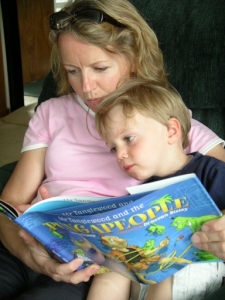| > Home > Reading Together > Research > New Zealand Ministry of Education Documents relating to Reading Together® |
|
New Zealand Ministry of Education Documents relating to Reading Together®

Research Study at St Joseph's School
In 2007, the New Zealand Ministry of Education funded a research study [1] into the effectiveness of Reading Together®. The in-depth study (led by Dr Bryan Tuck) investigated the ongoing implementation (since 2005) of Reading Together® at St Joseph's School Otahuhu, Auckland. The research revealed:
- statistically significant gains in students' levels of reading comprehension,
- positive and constructive changes in parents' relationships with their children, and
- positive shifts in children's independent reading and relationships between teachers and parents.
The report of the St Joseph's School Otahuhu research study is available here (and is also available on Education Counts).
Reading Together®: Key features and related research findings
In 2009, a document summarising research evidence relating to Reading Together® (1982-2009) was prepared by The Biddulph Group at the request of Group Māori, Ministry of Education National Office, as part of Whānau Engaged in Learning initiatives within Ka Hikitia. The document is available here.

Ministry of Education's Leadership Best Evidence Synthesis
In 2009, the Ministry of Education's Best Evidence Synthesis School Leadership and Student Outcomes: Identifying What Works and Why [2] reported that:
Reading Together has proven to be a cost-effective intervention to support parents in assisting their children with reading. [p 162]
Further extracts from the Best Evidence Synthesis follow:
This case explores how one school developed educational connections with its families in a way that had a payoff in terms of impact on student outcomes. ... The case involves the implementation by a senior management team (SMT) of a parent tutoring programme known as Reading Together. Through this programme, schools work with parents to help them develop tutoring skills that have been demonstrated to improve reading comprehension and foster positive parent-child-teacher relationships. The SMT became interested in the programme because it was research-based, the evidence indicated substantially improved outcomes for students, and its demands on resources seemed reasonable in light of the potential gains. [Case 5, pp 236-241]
Note: The Reading Together® programme is also cited in Chapter 7 (pp 162-164) and Chapter 8 (p 188) of the Best Evidence Synthesis.
References
- Tuck, B., Horgan, L., Franich, C. & Wards, M. (2007). School leadership in a school-home partnership: Reading Together at St Joseph’s School Otahuhu. Research and paper completed with the financial support of the Iterative Best Evidence Synthesis Programme and the Pasifika Schooling Improvement Division of the Ministry of Education, Wellington, New Zealand.
- Alton-Lee, A., Robinson, V., Hohepa, M., and Lloyd, C. (2009). School Leadership and Student Outcomes: Identifying What Works and Why Best Evidence Synthesis. Wellington: Ministry of Education.
